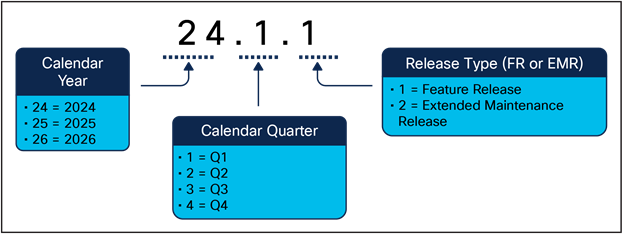IOS XR Release Taxonomy Bulletin
Available Languages
Bias-Free Language
The documentation set for this product strives to use bias-free language. For the purposes of this documentation set, bias-free is defined as language that does not imply discrimination based on age, disability, gender, racial identity, ethnic identity, sexual orientation, socioeconomic status, and intersectionality. Exceptions may be present in the documentation due to language that is hardcoded in the user interfaces of the product software, language used based on RFP documentation, or language that is used by a referenced third-party product. Learn more about how Cisco is using Inclusive Language.
This bulletin will provide you with information about the upcoming changes in the Cisco IOS XR operating system, including the new release taxonomy that will be deployed beginning in IOS XR 24.1.1, the transition plan, and resources available to support you. You will also learn about the benefits of the new versioning scheme and the transition to a quarterly release cadence.
Brief Overview of IOS XR Naming Scheme
The release numbering system of IOS XR, which follows the format X.Y.Z [X = major release number; Y = minor release number; Z = release type], has been historically used as the release taxonomy. This system ensures proper representation of relative maturity, feature inclusion, and support lifecycles. This system has served us well and has been a testament to our commitment to providing high-quality software for our customers.
However, we value customer feedback and continuously strive to enhance our products based on their needs and expectations. Thanks to your valuable insights we are implementing more intuitive and customer-friendly versioning scheme. In response to this feedback, we have made the decision to implement a new naming convention that aligns with these requests and improves the overall customer experience.
Please note that the release numbering change and cadence does not change the overall lifecycle of the releases of IOS XR. Please see Software Lifecycle Support Statement for exact timeline details for each release.
Transitioning to a New Release Strategy
Starting in 2024 with IOS XR 24.1.1, we will transition to a quarterly release cadence, with software updates being released every quarter. Under the new release plan, we will be releasing 4 Feature Releases (FR) and 4 Extended Maintenance Releases (EMR) per calendar year. The Extended Maintenance Releases will be released 90 days after the Feature Release. This new approach allows us to provide a more predictable and consistent release cadence, enabling customers to plan and manage their network upgrades more effectively.
By implementing this time-based release strategy, we aim to provide customers with greater flexibility, improved software availability, and increased transparency in terms of the age and stability of each release. Quarterly releases ensure that customers have access to the latest features, enhancements, and bug fixes. This transition also promotes the improvement of deployable software with high usability and ensures high-quality standards are maintained.
The examples in these guidelines use the X.Y.Z format for release version numbers, for example 24.1.1 (Figure 1).

X = Calendar Year
● 24 = 2024
● 25 = 2025
● 26 = 2026
● 27 = 2027
Y = Calendar Quarter
● 1 = Q1
● 2 = Q2
● 3 = Q3
● 4 = Q4
Z = Release Type
● 1 = Feature Release (FR)
● 2 = Extended Maintenance Release (EMR)
Feature Releases (FR)
Feature releases contain new features and support for new hardware. Feature releases will have the X.X.1 (dot one) designation. For example, IOS XR 24.3.1, and 25.2.1 would be considered feature releases. Feature releases are delivered approximately every 90 days. A Cisco IOS XR Software feature release is governed by the software lifecycle policy in the section Software Lifecycle Support Statement.
Extended Maintenance Releases (EMR)
A Cisco IOS XR Software Extended Maintenance Release (EMR) is signified by incrementing the third digit to X.X.2 in the release version number from the feature release. For example, IOS XR 24.1.2, and 25.2.2 would both be considered EMR releases. These releases are the primary mechanism to deliver groups of critical bug fixes to Cisco IOS XR Software feature releases. As a matter of course, EMR releases contain only zero feature bug fixes, and are delivered 3 months after a Feature Releases.
This bulletin provides an overview of the upcoming changes in the IOS XR operating system. The current versioning system will be replaced with a new YEAR.QUARTER.TYPE scheme, starting with IOS XR 24.1.1.
● The new naming convention aims to enhance predictability and transparency.
● Additionally, there will be a shift to a 90-day release cadence, ensuring more frequent updates and improvements.
● These changes in the IOS XR operating system aim to enhance the customer experience, provide a more efficient system for managing network infrastructure, and ensure a predictable and transparent upgrade process.
Cisco IOS XR Software has defined multiple software release types to address the two fundamental requirements:
● Feature releases every 90 days (to introduce new software and hardware features and sometimes hardware platforms or software architecture changes).
● Extended Maintenance Releases every 90 days to cumulatively fix problems found.
● SMUs to address critical bug fixes.
The Software Lifecycle Support Statement provides information on Cisco IOS XR release model and software support timeline.